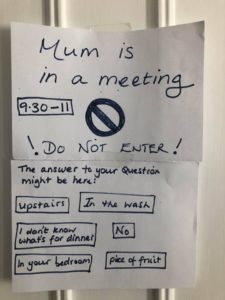When it’s 100% acceptable to show up in sweatpants and let your dog out in the middle of a call, you know meeting etiquette has changed a lot.
But just because no one will ever see your knees again doesn’t mean there isn’t proper virtual meeting etiquette.
Proper meeting etiquette in 2022 has little to do with how you dress and speak. It’s about how you prepare, treat others, and focus. If you define these rules for your team, you’ll get a lot more out of your digital meetings.
This article will explore online meeting etiquette for attendees. If you are looking for ground rules for running a meeting, or how to lead effective virtual meetings, check out our other resources.
Let’s start by assuming that everyone is calling in from distributed locations.
Online meeting etiquette for attendees who are remote
Ask for an agenda
If you get invited to a meeting without an agenda, it is good virtual meeting etiquette to push back and ask for one. Being forced to go to meetings without a plan is like someone stealing your chair. Time is the most precious resource in a digital workplace. If you let people steal it from you, then you are as much to blame as they are. Ask for an agenda and any pre-reading or pre-work you can do to be ready.
Check out our virtual meeting agenda template here.
Come prepared
Make time in your day to be ready for the meeting. Do your pre-reading. Leave comments on the agenda. Send notes if you want to add things to talk about. You can do your part to make the meeting great if you can jump into the discussion time as soon as possible.
Tell your brain it’s time for the meeting
Think about how you went to meetings when you were in the office. You stopped working, stood up, and stretched. You grabbed a notebook, and walked by the desk of coworkers to see if they were ready. You grabbed a quick cup of coffee and had a seat in a totally different room from where you were before.
What happens when you attend a virtual meeting from home? You work right up until 9:59am, click a link, and BOOM, you are in the meeting.
Good virtual meeting etiquette means not bringing all your baggage from the day.
How can you recreate this when working from home or a co-working space? Five minutes before the meeting, stand up, stretch, and go get something to drink. Consider logging in from a different room, or at least a different part of the room. If you don’t need to share visuals, take a walk. Or at least go put on some pants, just in case.
You are trying to make a shift from Focus work mode to Engaged. Otherwise, you’ll immediately start thinking about the other work you could be doing instead of being in the meeting. Changing your environment will help you stay engaged with the conversation instead of doing email.
Signal to others you are in a meeting
If you share space with others, let them know you are getting on a meeting. Everyone in a 20 foot radius should be fully clothed :-). Make it clear if it’s ok to interrupt you if they can’t find the scissors to cut off the top of the popsicle.

Prevent your distractions
Turn off all chat applications and notifications. Silence your phone. Close out any tabs that aren’t essential to the meeting. If you are a fidgeter, have something in your hand.
Log in early
Don’t wait until the last minute to log in. You will start off distracted, and you may forget to log in on time. Logging in five minutes ahead of time is good online meeting etiquette for attendees. Start some light conversation with others.
If you are going to be late, send a message to the meeting organizer so they know if they should wait for you.
The exception to showing up early is if you are joining as a guest on someone else’s platform. In such cases, you want to show up right on time. Start logging in 1-2 minutes early in case you run into issues with a new platform or installing software.
Start with video on
Video is a powerful way to maintain a human connection in a virtual meeting. Starting a call with a bunch of blank screens is pretty cold and impersonal.
If you are uncomfortable sharing your background, apply a filter or a blur. “I didn’t brush my hair” is not a valid excuse to keep your video off during a planned business meeting.
If connectivity or bandwidth is a problem, let everyone know you are going to turn your video off after saying hello.
Muting
Staying on mute unless you have something to say lowers the fidelity of the conversation. It gives others fewer signals to interpret. Even picking up on a quick laugh or “mmhmm” is helpful to whoever is talking.
Mute yourself when not speaking if:
- It is a large call of ten or more people
- You hear a feedback echo
- You have noise in your background
Otherwise, don’t mute.

Speak slowly
Be aware of non-native speakers on the call. Many rely on watching your face or reading lips to get the full context. Without those signals, they need you to slow down to make sure they catch what you say.
Don’t leave the room
You wouldn’t quietly sneak out the back door of an in-person meeting, would you? Online meeting etiquette for attendees is the same. If something urgent comes up, such as signing for a delivery at the door, leave a chat message to say you will be right back. If you have your video off, send another message when you return. This also prevents the awkwardness of being called on during the meeting and not answering.
Dealing with interruptions
If your cat, child, grandmother, or spouse walks into the screen, don’t freak out. By this point, everyone’s had this experience. It’s just another reminder that we are all humans trying to figure this out.
Chat side conversations
Is it bad virtual meeting etiquette to send chat messages? Not necessarily.
Chat during meetings can actually be a fun way to augment the experience and make it more fun for everyone.
But it can feel disrespectful to the person leading. If you’ve ever been the leader, you know how hard it is to stay focused and keep folks engaged.
Decide as a team on your ground rules for virtual meetings if it’s ok to use chat, but here are a few guidelines:
- The chat should be available to everyone. Quick, private side conversations are bad online meeting etiquette.
- Don’t make a comment that degrades someone.
- Be respectful of the meeting host.
Don’t talk over people
In a virtual meeting, it’s hard to know exactly who spoke first. Be ready to let the other person speak ahead of you. If you need to complete a statement, say something like, “Ramon, I just want to finish this thought, and then I want to hear what you have to say.”
Resist the urge to do other work
At some point you’ll get the urge to check your messages, research a catch phrase, or get lost finding the perfect GIF response. Doing work while on a meeting means you won’t be focused on either and both will suffer.
If you find yourself consistently distracted, here are a few things to try:
- Keep your hands in the video feed
- Take the call on a mobile device and shut down your laptop
- Always volunteer to share your screen for the group when required
- Change your atmosphere (see above)
Hybrid meeting etiquette
If you are at the office while others log in remotely, there is some extra virtual etiquette to follow for hybrid meetings.
Make sure you can be seen
Unless the room has a high quality telepresence video, log in with your video on just like everyone else. You may need to mute your microphone and turn your volume down to eliminate feedback.
If there is only one camera, don’t lean out of the picture. The video is there to give remote employees the best chance to simulate being together. If you can’t be seen, move yourself or suggest setting up another camera.

Be inclusive
Include remote callers in pre-metting chitchat. Direct questions specifically to remote attendees if you haven’t heard much from them.
No whispers
Don’t start a side conversation with someone else in the room where no remote team members can hear it. This is bad online meeting etiquette in any situation.
Defer to remote speakers instead of interrupting
If you and a remote attendee spoke at the same time, always allow the other person to go first.
Stick around afterwards
Some of the best conversations happen after the meeting is over. Instead of chatting with people in the office, give a remote team member a call right afterwards. Debrief the call and catch up for a few minutes.
The rules have changed
As with most things, digital has changed the face of meetings. Proper online meeting etiquette for attendees is new and changing every day. Virtual meeting etiquette exists to smooth out the digital experience so that everyone gets the most out of the meeting.
When it’s 100% acceptable to show up in sweatpants and let your dog out in the middle of a call, you know meeting etiquette has changed a lot.
But just because no one will ever see your knees again doesn’t mean there isn’t proper virtual meeting etiquette.
Proper meeting etiquette in 2022 has little to do with how you dress and speak. It’s about how you prepare, treat others, and focus. If you define these rules for your team, you’ll get a lot more out of your digital meetings.
This article will explore online meeting etiquette for attendees. If you are looking for ground rules for running a meeting, or how to lead effective virtual meetings, check out our other resources.
Let’s start by assuming that everyone is calling in from distributed locations.
Online meeting etiquette for attendees who are remote
Ask for an agenda
If you get invited to a meeting without an agenda, it is good virtual meeting etiquette to push back and ask for one. Being forced to go to meetings without a plan is like someone stealing your chair. Time is the most precious resource in a digital workplace. If you let people steal it from you, then you are as much to blame as they are. Ask for an agenda and any pre-reading or pre-work you can do to be ready.
Check out our virtual meeting agenda template here.
Come prepared
Make time in your day to be ready for the meeting. Do your pre-reading. Leave comments on the agenda. Send notes if you want to add things to talk about. You can do your part to make the meeting great if you can jump into the discussion time as soon as possible.
Tell your brain it’s time for the meeting
Think about how you went to meetings when you were in the office. You stopped working, stood up, and stretched. You grabbed a notebook, and walked by the desk of coworkers to see if they were ready. You grabbed a quick cup of coffee and had a seat in a totally different room from where you were before.
What happens when you attend a virtual meeting from home? You work right up until 9:59am, click a link, and BOOM, you are in the meeting.
Good virtual meeting etiquette means not bringing all your baggage from the day.
How can you recreate this when working from home or a co-working space? Five minutes before the meeting, stand up, stretch, and go get something to drink. Consider logging in from a different room, or at least a different part of the room. If you don’t need to share visuals, take a walk. Or at least go put on some pants, just in case.
You are trying to make a shift from Focus work mode to Engaged. Otherwise, you’ll immediately start thinking about the other work you could be doing instead of being in the meeting. Changing your environment will help you stay engaged with the conversation instead of doing email.
Signal to others you are in a meeting
If you share space with others, let them know you are getting on a meeting. Everyone in a 20 foot radius should be fully clothed :-). Make it clear if it’s ok to interrupt you if they can’t find the scissors to cut off the top of the popsicle.

Prevent your distractions
Turn off all chat applications and notifications. Silence your phone. Close out any tabs that aren’t essential to the meeting. If you are a fidgeter, have something in your hand.
Log in early
Don’t wait until the last minute to log in. You will start off distracted, and you may forget to log in on time. Logging in five minutes ahead of time is good online meeting etiquette for attendees. Start some light conversation with others.
If you are going to be late, send a message to the meeting organizer so they know if they should wait for you.
The exception to showing up early is if you are joining as a guest on someone else’s platform. In such cases, you want to show up right on time. Start logging in 1-2 minutes early in case you run into issues with a new platform or installing software.
Start with video on
Video is a powerful way to maintain a human connection in a virtual meeting. Starting a call with a bunch of blank screens is pretty cold and impersonal.
If you are uncomfortable sharing your background, apply a filter or a blur. “I didn’t brush my hair” is not a valid excuse to keep your video off during a planned business meeting.
If connectivity or bandwidth is a problem, let everyone know you are going to turn your video off after saying hello.
Muting
Staying on mute unless you have something to say lowers the fidelity of the conversation. It gives others fewer signals to interpret. Even picking up on a quick laugh or “mmhmm” is helpful to whoever is talking.
Mute yourself when not speaking if:
- It is a large call of ten or more people
- You hear a feedback echo
- You have noise in your background
Otherwise, don’t mute.

Speak slowly
Be aware of non-native speakers on the call. Many rely on watching your face or reading lips to get the full context. Without those signals, they need you to slow down to make sure they catch what you say.
Don’t leave the room
You wouldn’t quietly sneak out the back door of an in-person meeting, would you? Online meeting etiquette for attendees is the same. If something urgent comes up, such as signing for a delivery at the door, leave a chat message to say you will be right back. If you have your video off, send another message when you return. This also prevents the awkwardness of being called on during the meeting and not answering.
Dealing with interruptions
If your cat, child, grandmother, or spouse walks into the screen, don’t freak out. By this point, everyone’s had this experience. It’s just another reminder that we are all humans trying to figure this out.
Chat side conversations
Is it bad virtual meeting etiquette to send chat messages? Not necessarily.
Chat during meetings can actually be a fun way to augment the experience and make it more fun for everyone.
But it can feel disrespectful to the person leading. If you’ve ever been the leader, you know how hard it is to stay focused and keep folks engaged.
Decide as a team on your ground rules for virtual meetings if it’s ok to use chat, but here are a few guidelines:
- The chat should be available to everyone. Quick, private side conversations are bad online meeting etiquette.
- Don’t make a comment that degrades someone.
- Be respectful of the meeting host.
Don’t talk over people
In a virtual meeting, it’s hard to know exactly who spoke first. Be ready to let the other person speak ahead of you. If you need to complete a statement, say something like, “Ramon, I just want to finish this thought, and then I want to hear what you have to say.”
Resist the urge to do other work
At some point you’ll get the urge to check your messages, research a catch phrase, or get lost finding the perfect GIF response. Doing work while on a meeting means you won’t be focused on either and both will suffer.
If you find yourself consistently distracted, here are a few things to try:
- Keep your hands in the video feed
- Take the call on a mobile device and shut down your laptop
- Always volunteer to share your screen for the group when required
- Change your atmosphere (see above)
Hybrid meeting etiquette
If you are at the office while others log in remotely, there is some extra virtual etiquette to follow for hybrid meetings.
Make sure you can be seen
Unless the room has a high quality telepresence video, log in with your video on just like everyone else. You may need to mute your microphone and turn your volume down to eliminate feedback.
If there is only one camera, don’t lean out of the picture. The video is there to give remote employees the best chance to simulate being together. If you can’t be seen, move yourself or suggest setting up another camera.

Be inclusive
Include remote callers in pre-metting chitchat. Direct questions specifically to remote attendees if you haven’t heard much from them.
No whispers
Don’t start a side conversation with someone else in the room where no remote team members can hear it. This is bad online meeting etiquette in any situation.
Defer to remote speakers instead of interrupting
If you and a remote attendee spoke at the same time, always allow the other person to go first.
Stick around afterwards
Some of the best conversations happen after the meeting is over. Instead of chatting with people in the office, give a remote team member a call right afterwards. Debrief the call and catch up for a few minutes.
The rules have changed
As with most things, digital has changed the face of meetings. Proper online meeting etiquette for attendees is new and changing every day. Virtual meeting etiquette exists to smooth out the digital experience so that everyone gets the most out of the meeting.
)
)
)







